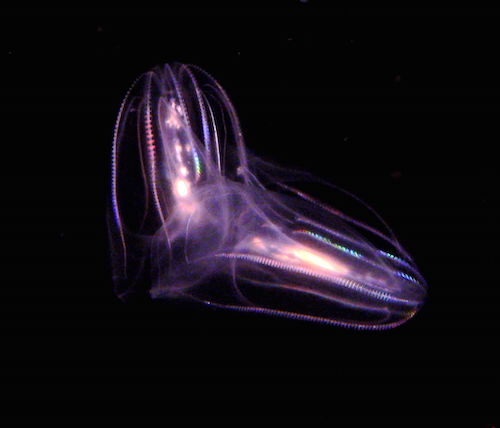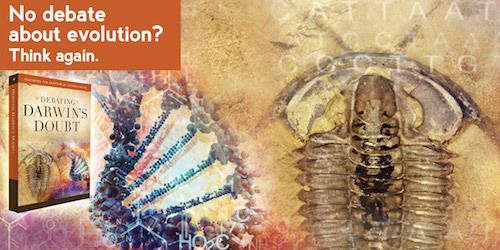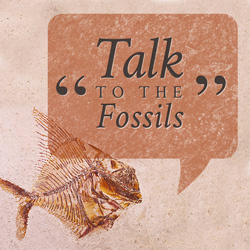Discovery Institute's Blog, page 142
July 29, 2015
Listen: Octopi, Sea Turtles -- and Living Waters

On a new episode of ID the Future looking forward to the upcoming Seattle premiere of Illustra Media's newest documentary, Living Waters: Intelligent Design in the Oceans of the Earth, Sarah Chaffee discusses octopus hatchlings, their "distributed intelligence" and survival instincts, highlighted in Geoffrey Simmons's book Billions of Missing Links.
Also, listen in and learn how baby sea turtles use an imprinted magnetic map to navigate the ocean. Living Waters explores the mysterious worl...
Research by Dembski and Marks Makes Inroads in Technical Literature

Intelligent design is making unmistakable progress in mainstream scientific thinking. Here's an example from a new paper in the journal of Soft Computing, "Heuristic algorithm based on molecules optimizing their geometry in a crystal to solve the problem of integer factorization." It cites the work of leading ID researchers William Dembski and Robert Marks of the Evolutionary Informatics Laboratory -- quite favorably so, not in order to critique them.
The paper discusses integer factorizatio...
Cecil the Lion's Killer Violated His Own Exceptional Obligations as a Human Being

The killing of Cecil the lion was a very bad thing. As I understand it, a sanctuary lion -- and tourist attraction -- was lured out of his safe zone at Zimbabwe's Hwange National Park and shot with an arrow, taking many hours to die.
I know that many have been making sharp contrasts comparing the outpouring of empathy for Cecil with the far lesser demonstration of concern about Planned Parenthood's dismembered fetuses. As cogent as those contrasts are, however, we should not allow them to di...
Earliest Comb Jellies Wore Armor

What does it take to wear armor? An animal has to be able to make the material and put it where it belongs. To be functional, the armor cannot interfere with the animal's movement. And the animal cannot simply glue sand particles on its exterior in a haphazard way. The appropriate materials, directed by genetic instructions, must be manufactured and placed holistically so that the finished armor provides a beneficial function. It would be surprising, under an evolutionary view, to find such...
July 28, 2015
Computing the "Best Case" Probability of Proteins from Actual Data, and Falsifying a Prediction of Darwinism
Biological life requires thousands of different protein families, about 70 percent of which are "globular" proteins, with a three-dimensional shape that is unique to each family of proteins. An illustration is shown in the picture at the top of this post. This 3D shape is necessary for a particular biological function and is determined by the sequence of the different amino acids that make up that protein. In other words, it is not biology that determines the shape, but physics. Sequences th...
In The New Yorker, Tom Wolfe Compares Persecution of Intelligent Design Advocates to the "Spanish Inquisition"

How did we miss this? The comment is brief but pungent to say the least. Interviewed by The New Yorker earlier this year, the great novelist and journalist Tom Wolfe acknowledged that he's writing a book about evolution -- actually, "a history of the theory of evolution from the nineteenth century to the present." No indication of what his overall thesis might be, but he "invokes the Spanish Inquisition when discussing how academics have cast out proponents of intelligent design for 'not bel...
The "Let's Kill for Organs" Meme Continues

We are a society of public policy promise breakers. Advocates for radical transformations in law and culture promise their proposed changes will be constrained and regulated by strict guidelines. Then, when the policy becomes law, it is often "Katy, bar the door" and the old promises are forgotten.
That pattern has not played out with organ transplant medicine. Yet.
Not for lack of trying, however. Many in bioethics and the transplant field want to break the important promise solemnly made t...
Listen: Stephen Meyer Talks About His Recent Debate with Alex Berezow on the Michael Medved Show

On a new episode of ID the Future, Discovery Institute's Andrew McDiarmid chats with Stephen Meyer and clarifies two interesting points raised during Meyer's recent discussion on the Michael Medved Show with Alex Berezow of Real Clear Science. Berezow pointed to developmental hox genes and the research of Richard Lenski as examples of the creative power of the Darwinian mutation/selection mechanism.
Here, Meyer observes that although hox genes can produce changes in an organism during devel...
July 27, 2015
Evolution Appears to Converge on Goals -- But in Darwinian Terms, Is That Possible?

Very different life forms frequently converge on eerily identical patterns of development (convergent evolution). That is odd if evolution is purely undirected and unplanned. There isn't enough time, given the history of the universe.
 And, as I've noted before, the welter of data coming back from paleontology, genome mapping, and other studies are changing paleontology from a discipline dependent on grand theories to one more like human history, dependent on identified facts.
And, as I've noted before, the welter of data coming back from paleontology, genome mapping, and other studies are changing paleontology from a discipline dependent on grand theories to one more like human history, dependent on identified facts.
A century or so...
Should We Have Faith in Science?

Many people today regard 21st-century science as a shining, monolithic spire of truth rising above the landscape of human ignorance and superstition. As a result, I often talk with people who fully apply all their critical thinking skills, and their full Internet-scouring abilities, to see if they can discover a weak link in evidence for the truth of Christian beliefs, but who have a complete, unquestioning faith in science.
Should you have blind faith in what science has become today? This...
Discovery Institute's Blog
- Discovery Institute's profile
- 15 followers




